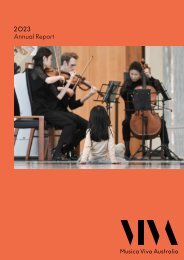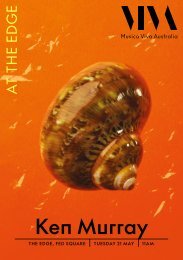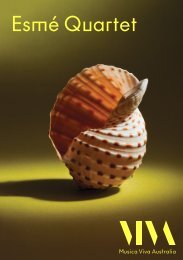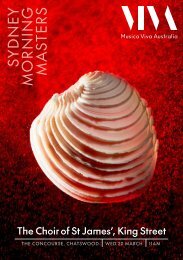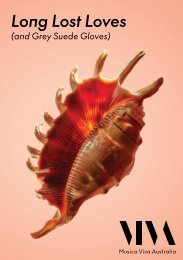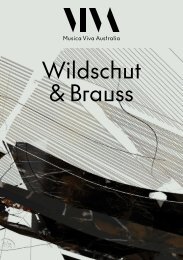Orava Quartet & Daniel De Borah Program Guide | March 2022
Create successful ePaper yourself
Turn your PDF publications into a flip-book with our unique Google optimized e-Paper software.
The fourth movement, Andante molto<br />
sostenuto, steers away from the intense<br />
energy of the first three movements<br />
but reveals an eerie darkness. After<br />
a passionate interchange of thematic<br />
material, the flame of the piece is gradually<br />
consumed by darkness around it and<br />
vanishes into nothingness.<br />
ROB HANSEN © 2016<br />
Wojciech Kilar’s Orawa is a piece that my<br />
brother <strong>Daniel</strong> and I grew up listening to<br />
as children, and which ultimately became<br />
our namesake. Orawa refers to a region<br />
near the Polish-Slovak border marked<br />
by rugged, mountainous terrain, and this<br />
piece is the final work in Kilar’s so-called<br />
‘Tatra Mountain Works’. It is inspired by<br />
Polish highland folklore and portrays the<br />
dramatic landscape, as well as the river<br />
that runs through it. In his own words<br />
about the work, Kilar had ‘dreamed of<br />
creating a piece inspired by a highlander<br />
band. It is pretty much a piece for a<br />
magnified folk band and one of the rare<br />
examples where I’ve been happy with my<br />
work.’<br />
© KAROL KOWALIK<br />
The early 1840s were productive and<br />
exciting years for Schumann. In 1840,<br />
following an acrimonious legal battle with<br />
his teacher, and unwilling future fatherin-law,<br />
Friedrich Wieck, Schumann had<br />
married his beloved Clara. Inspired and<br />
encouraged by her, he turned his attention<br />
from the solo piano music that had<br />
dominated his output to compose songs,<br />
orchestral works and, particularly in 1842,<br />
chamber music; the three String <strong>Quartet</strong>s<br />
Op. 41, the Piano <strong>Quartet</strong> Op. 47, the first<br />
version of the Fantasiestücke Op. 88<br />
and the Piano Quintet Op. 44, which was<br />
written during September and October.<br />
Schumann’s was the first Piano Quintet<br />
that can truly be called great, and it<br />
did much to establish his name as a<br />
composer. Clara, the Quintet’s dedicatee,<br />
was delighted. However, owing to her<br />
ill-health at the time of the work’s private<br />
premiere on 6 <strong>De</strong>cember, Schumann’s<br />
friend Mendelssohn stepped in to play<br />
the demanding piano part at sight,<br />
although Clara participated in the first<br />
public performance on 8 January 1843.<br />
Extraordinarily, the Quintet gained the<br />
approbation of Berlioz, who himself wrote<br />
no chamber music and was critical of<br />
Mendelssohn.<br />
Liszt, who unexpectedly visited the<br />
Schumanns in Leipzig, remarked<br />
condescendingly, ‘No, no, my dear<br />
Schumann, this is not the real thing:<br />
it is only Kapellmeister music’. This<br />
opinion and some disparaging remarks<br />
about Mendelssohn greatly offended<br />
Schumann, yet Liszt’s oblique reference<br />
to the influence of Bach was not wholly<br />
wide of the mark. Robert and Clara had<br />
together enjoyed playing and analysing<br />
his Well-Tempered Clavier. ‘Our fugal<br />
studies continue,’ she noted in her diary.<br />
‘Every time we play one it becomes more<br />
interesting for me. Such great art with such<br />
a natural flow.’<br />
The Piano Quintet has affinities with the<br />
seventh prelude and fugue from Book 1,<br />
with which it shares its key and, possibly,<br />
also the distinctive pair of upwardleaping<br />
intervals with which it opens. But<br />
where Bach achieves a yearning mood,<br />
Schumann’s approach is much bolder and<br />
extroverted, exploring a wider range of<br />
emotional ground overall.<br />
The first movement weaves two prominent<br />
themes, the striding pair of rising intervals<br />
and a more lyrical second subject, into<br />
a tightly argued yet expansive Sonataallegro<br />
in which the piano contributes to<br />
the rich Romantic instrumental textures<br />
|<br />
7<br />
|











